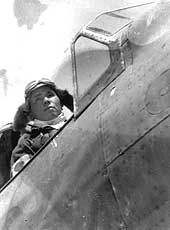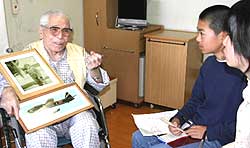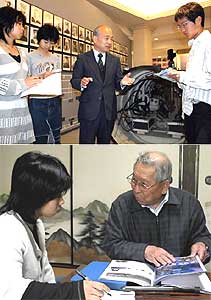A mission of death
Suicide attack and the value of life
"Please live a long life." A son shared this hope with his parents before he died in a suicide attack. And a father wrote to his children, "Don't envy your friends who still have a father."
These thoughts appeared in the final writings of pilots who committed "kamikaze" suicide attacks in World War II. At a museum dedicated to their memory, located in Kagoshima Prefecture, visitors are moved by the last words of these young men.
In the city of Shunan, about 80 kilometers from Hiroshima, there is another memorial museum involving suicide attacks called "kaiten". "Kaiten" were manned torpedoes designed to strike enemy ships and the museum shares the experience of these men.
For us, it was shocking to discover that these pilots and torpedo crewmen, who believed they were dying to protect the people they loved, were almost the same age as we are now. The junior writers heard stories from two men who trained for these "special attacks" : one was a pilot and the other was a torpedo specialist. As a result of these interviews, we reflected on our own lives and the value of life itself.
Most pilots were youth under 30
In October 1944, after the battle of Leyte Gulf, the Japanese military intensified its strategy of "kamikaze" suicide attacks. And by the end of the war, 5843 pilots had died, most of them young men under the age of 30.
These men loaded bombs into their airplanes, boats, and torpedoes and crashed them into enemy ships so there was very little chance that they would survive the attack.
In the spring of 1945, the American army landed on Okinawa. In response, the Japanese military set up a special base in the city of Chiran in Kagoshima Prefecture to serve as the nearest base to Okinawa for "kamikaze" pilots. In all, 1036 pilots died in action, including 439 pilots who departed directly from Chiran.
In addition, from November 1944 to the end of the war, 89 crewmen of the "kaiten" manned torpedoes died in their attacks. (Kyoko Niiyama, 17)
Mr. Shinmoto, a former "kamikaze" pilot
 |
Mr. Shinmoto boarding a training flight. |
We spoke with Iwao Shinmoto, 82, a former "kamikaze" pilot who lives in Hiroshima. Despite poor health, he was eager to share his experience from his hospital room.
 |
Mr. Shinmoto holds a photo of an "Ohka" plane and talks about his experience. (photo by Rikako Okada, 16) |
Since he was a child, he had longed to be a pilot. When he was 19 years old, without consulting his parents, he joined a training unit for "kamikaze" attacks. After completing flight instruction, he became part of the Ohka unit. Ohka was the name of a 6-meter-long airplane with explosives loaded on top. For an airplane it was rather small, but in fact, it was basically just a human bomb that was dropped by another, larger aircraft as they approached the enemy fleet.
He was stationed at a base in Ibaraki Prefecture near Tokyo. He had no idea when the order would come for his mission, which would mean his death. Mr. Shinmoto recalled, "I wasn't really afraid. To be honest, no one wanted to die, but we couldn't express these feelings at the time because there seemed to be no other way to protect our country."
But the war ended before he was ordered to attack. "I was so happy to return home alive," he said. "Life shouldn't be ended in such an awful way. I pray these kind of suicide attacks will never occur again."
We want to learn more about this issue and share the experience of former "kamikaze" pilots with many people. (Masahiro Mikoshi, 14)
Click to watch the interview with Mr. Shinmoto.
Mr. Nishimoto, former crew member of the "kaiten" manned torpedo

 |
(above): At the museum, we learned about the "kaiten" torpedo in front of a model of the cockpit and portraits of dead crew members. (photo by Kyoko Niiyama, 17) |
In order to learn about the manned torpedoes and their crew members, we visited the Kaiten Memorial Museum in the city of Shunan. After this visit, we spoke with Kazuo Nishimoto, 75, a former torpedo specialist who lives in Kure, not far from Hiroshima. He managed to survive because the war ended before he was ordered to attack.
The "kaiten" was basically a large bomb with a cockpit. The crew sat in the cockpit and crashed the torpedo into an enemy ship. In front of the museum, we saw a full-scale model of a torpedo, 14.75 meters in length. Two young naval officers conceived this idea and it was adopted by the navy as a new weapon in August 1944.
The word "kaiten" means "to rotate, revolve" -in other words, to reverse the tide of the war. The Japanese military recruited volunteers and established "kaiten" bases, with the first base opening in September 1944 on Otsu Island.
In 1943, Mr. Nishimoto volunteered for the navy and began training when he was 16 years old. The next year, in August, he was suddenly forced to decide if he would join the crew of a new "special weapon" -and he was given only five minutes to make this decision. Although the description of this weapon was vague, he quickly guessed that it was likely a suicide bomb of some kind. However, his passion to fight prompted him to accept the assignment. He explained, "At that moment, I didn't feel much fear of death."
By the end of the war, approximately 420 torpedoes were produced and 1375 men were trained as crew members. 104 of these men died in attacks or in training accidents. In fact, as of April 2007, it has been confirmed that only seven US ships were damaged or sunk by these "kaiten" torpedoes.
Mr. Nishimoto recalls that his friend died at the age of 18 in an attack that took place just one month before the war ended. About this young man he had trained with, Mr. Nishimoto said, "Even now, I feel sorry he didn't survive, too."
He doesn't dwell on his decision to join the torpedo unit because, in a sense, he had little choice. "From a young age, we were programmed to give our life to our nation and the emperor." Then he added, "Youth today can enjoy freedom, so I hope they study hard, learn to think for themselves, and find ways to promote peace." (Yutaro Honkawa, 17, and Rikako Okada, 16)
Discussing our reactions and our ideas
After these interviews, the junior writers discussed our impressions of suicide attacks.
Before we spoke with these men, we couldn't really understand why they would sacrifice their own lives to defend their country. However, some of us grew sympathetic after realizing that their basic aim was to protect the people they loved-a wish that we ourselves might have. And others felt pity for them, as the militaristic culture of that time forced these choices. So, the love of community and country, taken to an extreme, may result in this sort of willingness to sacrifice one's own life.
We also discussed suicide bombings by terrorists in the Middle East. Some suicide bombers use vehicles to crash into places where many people have gathered. There may be similarities between these attacks and the Japanese attacks, but they're also quite different in that they involve the indiscriminate killing of civilians. One person added, "Those attacks provoke prejudice against religion, like the idea that Islam is bad. But the US military's presence in Iraq may be inciting them to commit such attacks."
We all agreed, though, that suicide attacks are unacceptable and we considered possibilities to prevent them in the future. Our ideas involve studying more about suicide attacks in school and creating stronger ties among countries to avoid war. (Minako Iwata, 13)
- Pacific War
Part of World War II in which Japan and the Allied Forces, led by the US, battled in Asia. It began in 1941, with the attack on Pearl Harbor, and it ended in August 1945 with Japan's surrender after atomic bombs were dropped on Hiroshima and Nagasaki.
- Battle of Leyte Gulf
One of the most intense battles between Japan and the US took place in October 1944 in Leyte Gulf in the Philippines.
- Training unit
Training unit Training program for the navy. Young men enlisted before they were drafted and underwent basic training. After this, they were trained to be pilots--including, later on, "kamikaze" pilots. But, towards the end of the war, there was a shortage of planes and fuel.
